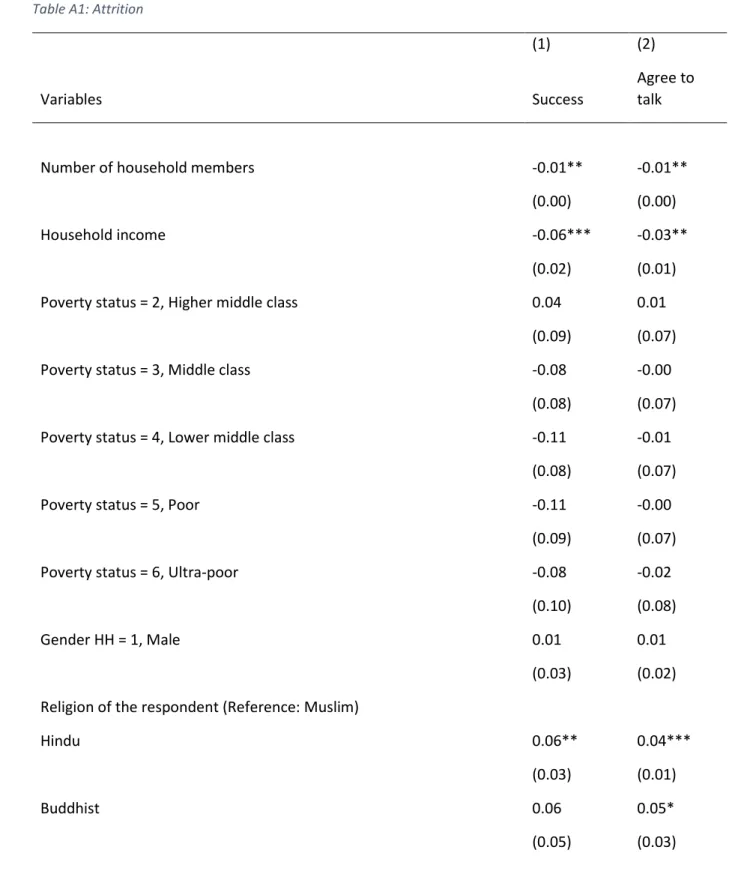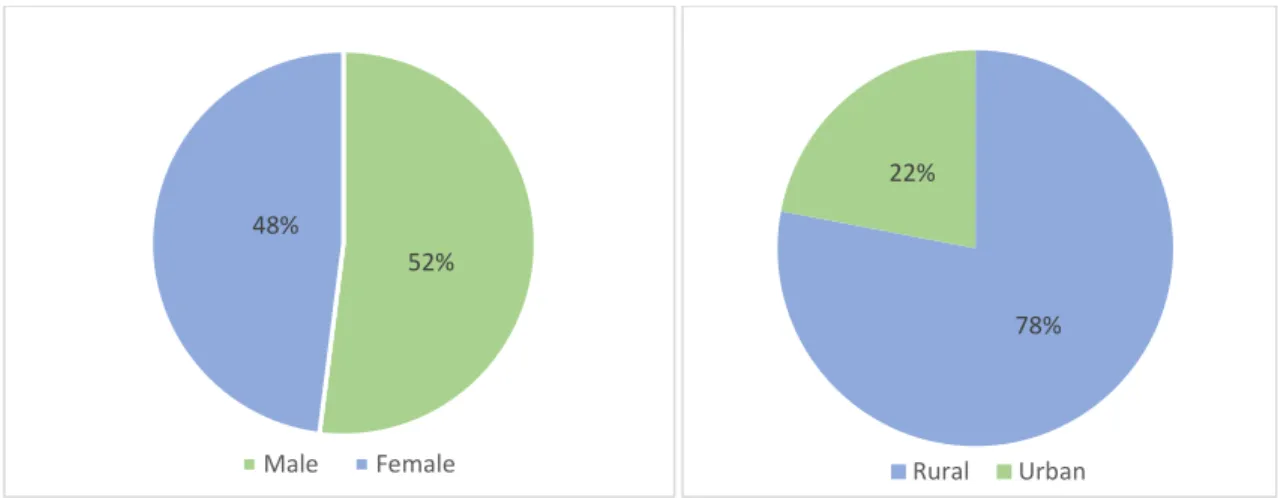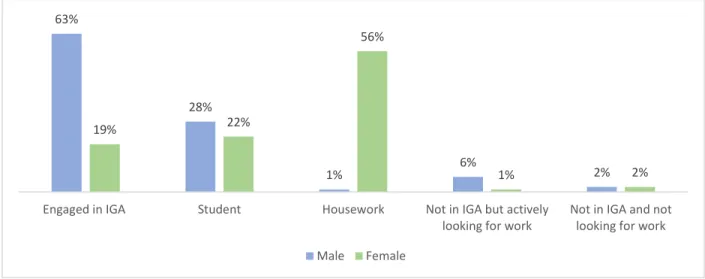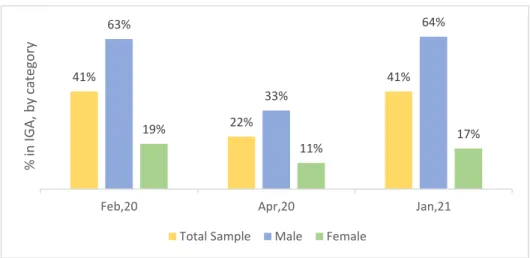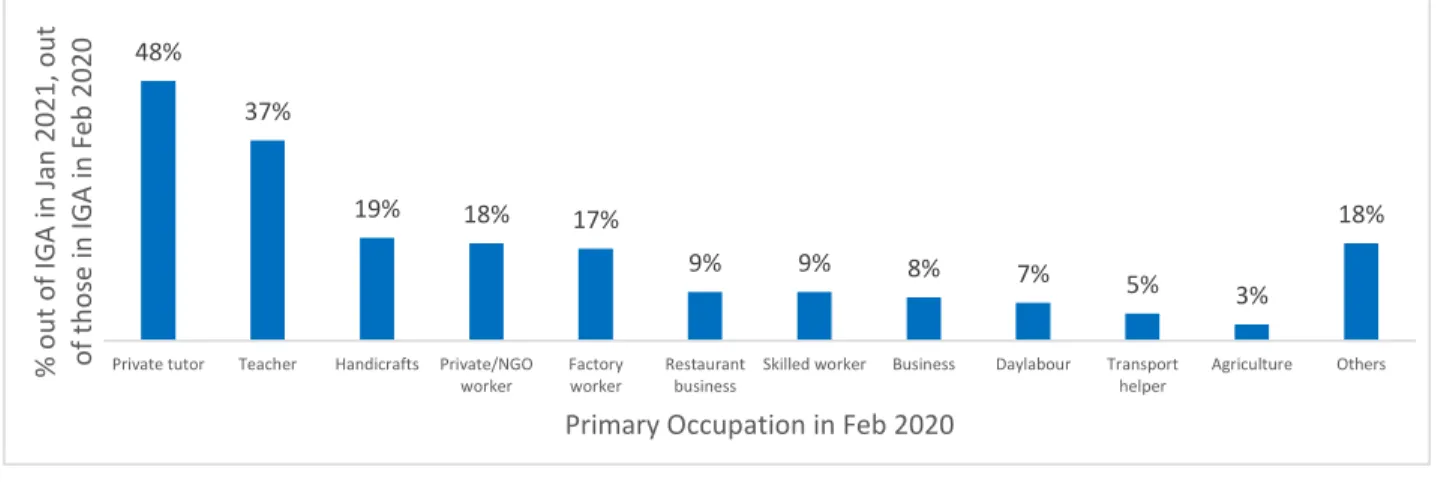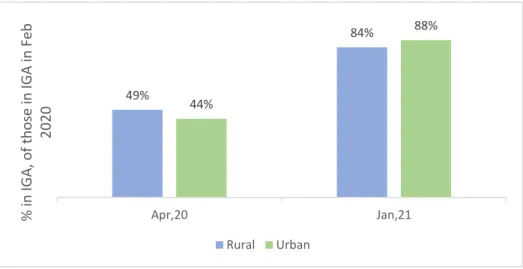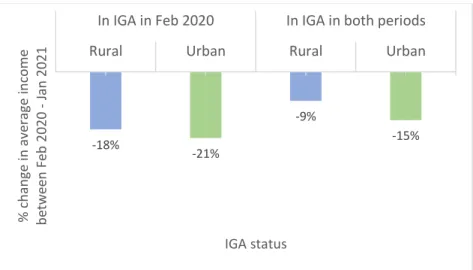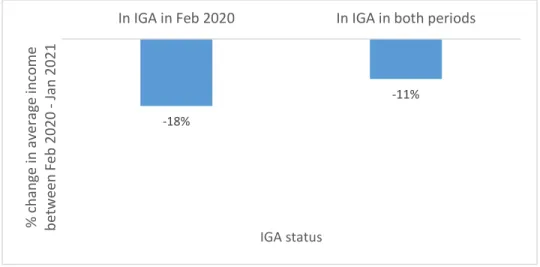Median income fell for all young people, with young women experiencing greater cuts despite being employed after the pandemic. Interestingly, the majority of young people felt that the impact of the pandemic was greater on men than on women. The majority of young people indicated that they wanted to be vaccinated; youth transitioning from working before the pandemic to not working now were the most willing.
A significant proportion of young people in our social media sample agreed that they had attended training in the past year, compared to almost none in the main survey.
Introduction
Findings show 15% of youth involved in income generating activities (IGA) before the pandemic were still out of IGA seven months after the economy resumed in January 2021. Young women disproportionately experienced job loss and lost income, as well as hours worked, compared to young men. Interestingly, although young women had a greater negative impact, most youth, both male and female, thought that the pandemic affected young men more than women.
The self-reported burden of housework increased for all young people; young women reported a slightly higher increase.
Methodology and Sample Description
- Sampling Technique
- Response Rate
- Sample Description
- Youths’ Pre-Pandemic Occupational Status
- Study Limitations
We used these data as a reference point for the employment status of young people before the economic shock. One tenth of young men and 7% of young women have higher education (Figure 4). Forty-two percent of youth were engaged in IGA in February 2020; however, a greater proportion of young men (63%) were engaged in IGA, compared to only 19% of young women (Figure 5).
While the proportion of male and female students was quite similar, 56% of young women are involved in household work compared to only 1% of young men.
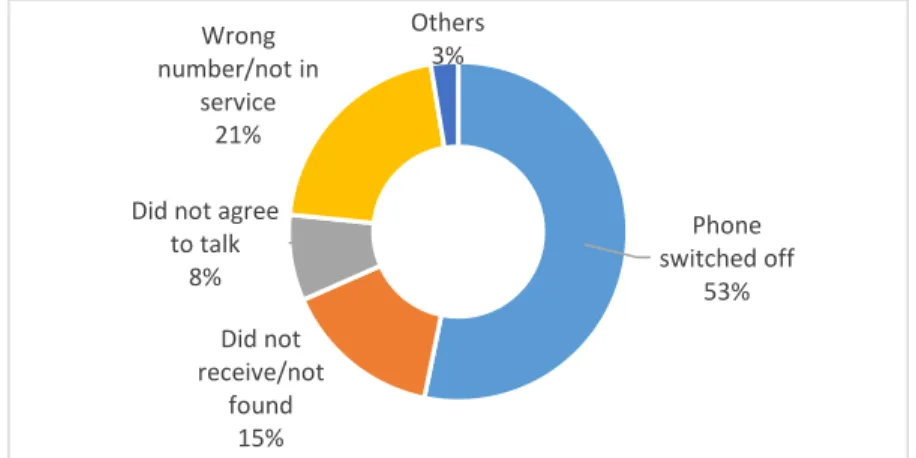
Employment, Income, and Working Hours
- Youths in IGA
- Youths’ Pre-Pandemic Engagement in IGA
- Youths’ Pre-Pandemic Engagement in IGA: Rural-Urban
- Working Hours of Youths in IGA (Working Pre-COVID and Now)
- Income of Youths in IGA
- Earnings Gap Across Locality
- Confidence in Getting Into IGA in the Post-COVID Scenario
This means that of the young people who were in IGA before the pandemic, almost 15% were not in the labor market in January 2021. We focus our analysis here on young people who were in IGA in two periods: before the pandemic in February 2020 and seven months after the resumption of economic activities in January 2021. For the two time periods, we compared the change in average monthly income between two groups : (i) young people who were in IGA in February 2020 (may still be working or not working in January 2021) and (ii) young people who were in IGA in both time periods - February 2020 and January 2021.
Young people who were working before the pandemic faced an 18% drop in average monthly earnings between February 2020 and January 2021 (Figure 10). We found in the previous section that 15% of young people who were working before the pandemic were no longer in IGA. So this figure reflects the drop in average earnings of those young and those who were working in January 2021.
In contrast, the percentage decrease in average earnings for youth who worked in both periods was 11%. Although lower than the decline in the entire sample6, the data imply a significant loss of income even among young people who worked in both periods. 6 By full sample we mean in this case the young people who worked before the pandemic (regardless of whether they worked or not in January 2021).
Among young people who were in IGA in February 2020, young people from urban areas faced a greater drop in income (21%), compared to rural young people (18%) – of approximately two percentage points (Figure 11 ). Youth in urban areas who were in IGA faced a 15% drop in average income, compared to youth in rural areas (9%).
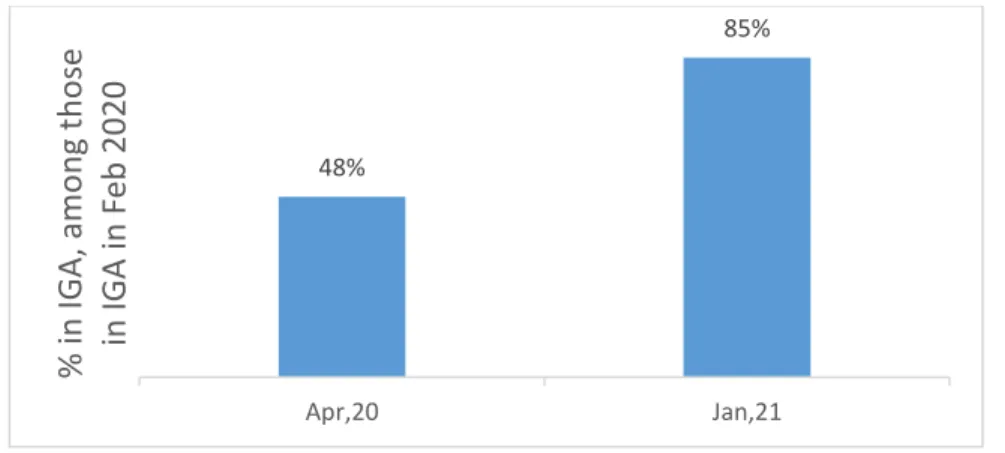
Effects of COVID-19 on the Mental Wellbeing of the Youth
Average Mental Health Score
Percentage of Youths in Possible Anxiety or Depression
In April 2020, the percentage of young women with possible depression or anxiety was 31%; 25% of young people were in this category. The need to invest in youth mental health support has been identified as one of the most important short- and medium-term policies to help young people recover from the negative impact of the pandemic (Donovan & Zentner, 2020; Etheridge & Spantig, 2020). Scores between 7-17 represent possible depression or anxiety, scores between 18-20 suggest possible depression or anxiety, and scores between 21-35 give no indication of anxiety or depression.

Response to Statement on “I’ve been feeling anxious”
Are Female Youth Facing the Brunt of the Economic Impact of COVID-19?
- Greater Burden of Loss in Employment, Hours of Work, and Income on the Female Youth
- Young Women Are Also Less Confident About Joining IGA in Future
- Urgency of Addressing Challenges in Skills and Employment Faced by Young Women
- Perception: Which Gender Was Most Affected by the Pandemic?
Young women are also much less likely to be confident about joining the IGA in the future. Among those in IGA in January 2021, 62% of women reported having higher confidence to enter future earning activities, compared to 74% of men. There are many reasons behind young women's lower confidence – ranging from women's own perceptions of having lower skills in securing jobs to the fact that they have lower opportunities to enter the labor market ( Matin et al., 2019).
Young women already in IGA are also much less confident than men, which may be due to the nature of the jobs. The urgency of addressing skills and employment challenges faced by young women Young women. As we see, not only do young women struggle much harder than young men to earn and maintain their livelihood, but they also face a much greater reduction in their working hours and income than the male youth.
Long-term unemployment, as many young women are facing, can also motivate many women to leave the labor market permanently, as women often face a difficult choice between career and family responsibilities, presented by prevailing gender norms (Kabeer et al., 2021). . The gendered nature of work across industries, along with the lack of systemic progress in addressing women's societal barriers may partly explain why livelihood recovery among young women is so low. Since a large proportion of young women and almost no young men in our sample are engaged in housework, we compared between women who were in IGA in February 2020 and women who were engaged in housework.
Young women who were in the IGA in February 2020 were more likely to believe that the impact was greater for women (17%) compared to young women who did. Yet an overwhelming majority of both young women and men, regardless of their involvement in the IGA, believe that men were worse off.
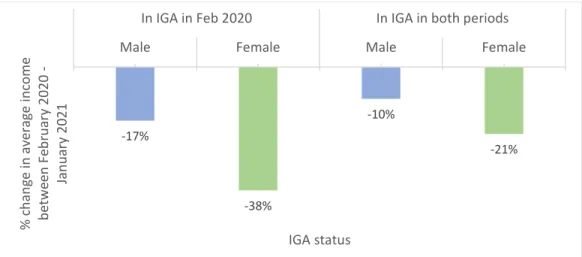
Perceptions on Social Impacts of COVID-19
- Perceived Social Impacts on the Uncertainty Over Examinations
- Perceived Social Impacts of School Closures
- Perceived Social Impacts of Granted Auto-Pass in HSC
- Youth’s Self-Assessed Changes in Activities
When we recorded more responses during the survey, most of the respondents (34%) believed that prolonged school closures had demotivated students' willingness to study and hampered youth education (9%). Increased student dependence on social media 9 Increased students' unnecessary social gatherings 9 Increased criminal activities in society 6 Demotivated students' desire to study 34. The majority of young people (38%) perceived that this meant that good students lost the ability to differentiate themselves. .
We asked young people about changes in certain activities in their lives in the past year. Fifty-five percent of the female youth and 525 of the male youth in our sample reported an increase in household chores (Figure 19). So while both men and women reported an increase, women can still take on most of the work.
A slightly higher percentage of male youth reported a decrease in study time (81%), compared to female youth (77%). This discrepancy is even sharper between male and female youth: while only 22% of male youth reported no change in their virtual communication, this was the case for 39% of female youth. On the other hand, 64% of male youth reported an increase, compared to only 40% of female youth.
According to the Global System for Mobile Communications Association (GSMA) Mobile Gender Gap Report 2019 (GSMA Intelligence) of adult men in Bangladesh have mobile phones and 30% use the Internet, while the figures are only 58% and 13% for women For similar underlying reasons in our study, we also observe differences in changes in young people's virtual communication.
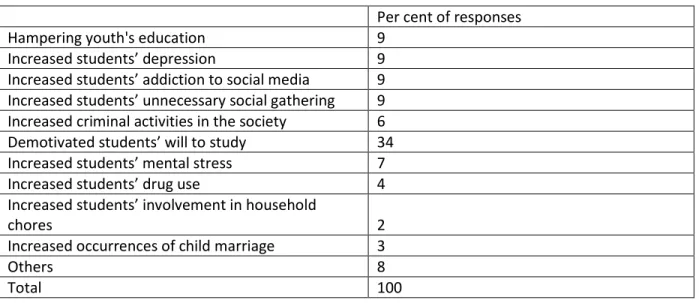
Willingness to Vaccinate
- Employment Status and Willingness
- Private Tutors and Willingness
- Household Size and Willingness
- Education Level and Willingness to Get Vaccinated
Young people who reported a higher number of household members over 40 years of age were more willing to get vaccinated. Willingness was highest among those who had more than three household members over 40 years of age. The higher the education of the respondents, the higher the proportion of young people who are ready to get vaccinated.
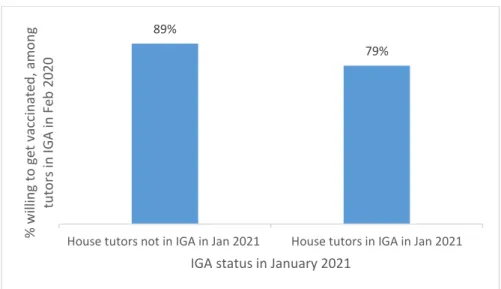
Youth’s Digital Life
Duration and Cost of Using the Internet
Purposes of Using the Internet
Mobile Banking
Social Media Survey
- Methodology and Descriptive Statistics
- Mental Well-Being
- New Training
- Perception: Which Gender Was Most Affected by the Pandemic?
- Differences With Nationally Representative Phone Survey
Four in five respondents to the social media survey said they have been dealing with mental health issues since the start of the pandemic. Across all occupational categories, a similar percentage of students and those engaged in IGA reported experiencing mental health problems in the past year (77%). A larger percentage of unemployed and job-seeking young people (92%) reported having psychological problems (figure 31).
From our social media sample, 27% of young people reported having completed some form of training/online courses between March 2020 and February 2021. A higher percentage of young people involved in IGA took up new training (35%), compared to students (25%) and the unemployed and job seekers (16%). Eighty-five percent of young people also believe they need a new form of training to find jobs in the post-COVID labor market – 34% of young people mentioned the need for ICT-related training, followed by online academic courses (20% ) and management-related courses (13%) (Figure 33).
In contrast to what we found in the telephone survey, a much larger percentage of young people surveyed online perceive that women are more affected than men by the pandemic. Overall, 23% of young people said women were more affected by the pandemic, compared to 77%. These findings are in stark contrast to our nationally representative telephone survey, where very few young people participated in any form of new training, or even believed that new training would help them find a job in the post-Covid period.
Less than 5% of youth in the telephone survey had received any new training in the past year, and less than 50% of youth in that sample thought there was a need for one in the post-COVID labor market. However, the biased nature of our sample, more educated and likely from higher socioeconomic backgrounds, highlights the existing inequality as well as the possibility that the pandemic will increase inequality.

Conclusion
Retrieved from https://bigd.bracu.ac.bd/wp-content/uploads/2021/01/Livelihoods-Coping-and-Recovery-During-COVID-19-Crisis_PPRC-BIGD-2nd-RRR.pdf.
